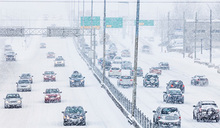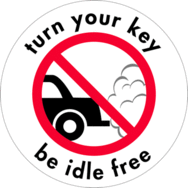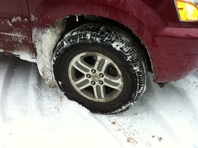
Frigid temperatures, icy roads, and blowing snow can be hard on drivers’ nerves—and their vehicles—in the winter. When the mercury plunges, fuel efficiency can
fall 20% or more and air pollution can increase.
Hybrids fare even worse—their fuel
economy can drop over 30% in cold weather.
Follow these
tips to increase your car’s wintertime fuel economy and reduce polluting emissions .
1.
Check your
tires. Tires lose pressure when
the temperature drops. Properly inflated tires improve gas mileage and prolong the life of the tire. Check your tire pressure at least monthly in the winter.
2.
Maintain your
vehicle. A well-maintained vehicle
uses less fuel and pollutes less. According to the U.S. EPA and the U.S. Department of Energy, fixing a car that is out of tune can improve its gas mileage by an average of 4%
|
 3.
Don’t idle. It’s not
necessary or even advisable to warm vehicle engines more than
30 seconds in the winter. Most cars built in the last couple of decades
have electronic engines in place of carburetors and warm faster
when they are moving.
Vehicles should also be turned off when stopped for more than 10 seconds. After 10 seconds, it takes more gas to idle than it does to restart the engine. An idling vehicle also creates more pollution than a moving one.
4.
Combine trips. It takes longer in cold weather for your car
to reach its most fuel-efficient operating temperature. Combine tripts to help keep the engine warm and saves on gas. For optimum
operating efficiency, make your longest stop your first stop. Consider using a
GPS device or your phone to plan your route.
|
 5. Remove junk from the trunk and clear snow and
ice. Reducing weight increases
your MPG and reduces vehicle pollution. Clear ice and snow, including in the wheel well area, to reduce vehicle weight and tire interference.
6. Remove drag. When not in use, remove roof racks
and other accessories that increase wind resistance and decrease MPG.
7. Avoid peak travel times. This is good advice any time of
the year, but especially in the winter when icy roads can slow traffic to a
crawl.
8. Turn off seat warmers and
defrosters. Use
seat warmers and defrosters sparingly. You’ll get better MPG when they’re off.
9. Preheat the cabins of hybrid and
electric vehicles. Preheating
the car’s interior while it’s plugged into the charger can extend its range.
10. Don’t drive. Keep your car parked when the weather is
bad. You’ll be safer and your vehicle will get better fuel efficiency if you wait to drive until the snowplows clear the roads. If permitted, work from home or take public
transportation to your destination.
Resources
|
Not sure what to do with those old or no longer-working strings of
holiday lights? Making the switch to energy efficient LED holiday
lights? Either way, recycle the old lights!
Recycle Your Holidays™ is a one-of-a-kind statewide holiday light
recycling program in Minnesota created and managed by the Recycling
Association of Minnesota (RAM). Drop off unwanted
light strings at any of the 450+ participating locations during the
holiday season through the end of January.
Bring your extra seeds and your clean clothes, shoes, and accessories to swap with others at Do It Green! Minnesota's Clothing and Seed Swap on January 30, 2016, 2pm to 4pm, at Mount Olive Church in Minneapolis. Get rid of what you don't need and take home cool new-to-you things. Free and open to the public; donations welcome.
Thank you for reading Living
Green 365. This newsletter is a publication of the Minnesota Pollution Control
Agency. Please send questions or comments about living green to the address
below.
Sincerely,
Erin Barnes-Driscoll and the Living Green Team
livinggreen365.pca@state.mn.us
|